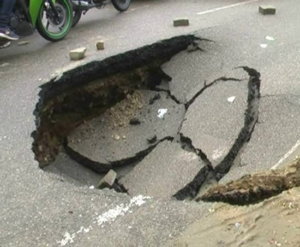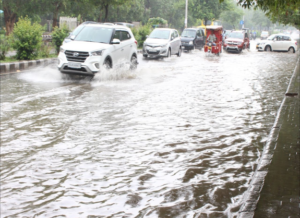Every monsoon we see familiar scenes of flooding in our towns and cities overwhelming our urban infrastructure, inundating our roads and highways with huge quantities of water for days. On the other hand, for remaining months of the year our cities have to fight a never-ending battle against water scarcity and depleting water tables.
This imbalance is a man-made crisis caused by concretization of surfaces, filling up of ponds and lakes for urban land-use, increasing density of building infrastructure and reduction of green spaces around our cities.
How can we address this imbalance?
A good starting point is to re-phrase the problem of flooding in our cities. Rather than consider it only as a storm-water drainage issue we should consider using our roads and highways as water catchment areas for ground water recharge.
The massiveness of the roads & highway infrastructure as rain water catchment area would be astonishing once we take into account the length and breadth of this catchment. While water scarcity is looming large in most parts of India we have comfortably preferred to ignore the hundreds of thousands of square kilometers of ready in-hand catchment.
Using our urban infrastructure to also help recharge our ground water reserves is a sustainable approach with many benefits however, it requires careful study to be designed and implemented correctly.
Some people are of the opinion that rain water falling on the roads should not be recharged since there are contaminants like rubber remnants from friction of tires and oil spillage on roads due to vehicular traffic.

Some engineers avoid rain water harvesting beside the road due to fear of road collapse due to shifting of soil.

Some people wonder if it is even possible to hold back, guide and recharge the rain water falling on roads and highways.

To begin with, we at SILVERON firmly believe that every drop of rain water must be prevented from running off long distances on the road, must be prevented from evaporation and must be recharged into the ground close to where it falls.
There are surely some contaminants on the roads but most of them are not water soluble and also during the rains the dilution levels are extremely high hence we should not lose out on this opportunity.
Recharge of rain water along these highways also support the idea of recharging rain water where ever it falls thus benefiting the entire area at large.
It must be underscored that recharging rain water close to a road is a highly specialized work since there is a risk of shifting of soil from under the road into the rain water harvesting structure leading to development of hollow space below the road which may not be visible at the first instance but may cause caving over time creating risk for commuters.
We at SILVERON have years of experience in building rain water harvesting and ground water recharge structures that are designed to perform alongside roads. Through are experience, we have following suggestions to offer:
- Highways should have a proper slope on both sides from the center for water to immediately flow towards the edge of the road. This will not only prevent the road from damage but will put the water into shallow storm water drain running along road’s edges.
- Storm water drain should have baffle walls a regular intervals. and these drains may not be covered and instead filled with 40 mm gravel to prevent any paper trash, poly bag, cloth etc. from chocking the drain while allowing the water to easily enter it.
- A SILVERON design recharge shaft should be constructed on the outside of the drain preferably between two baffle walls and connected to the drain .
- The recharge shaft design has to be modified such that the water from the drain is released into the recharge shaft bore sufficiently below the ground level so that it can percolate deeper into the ground. This will not disturb the compaction of the road.
- Restaurants, shops or petrol pumps abutting the highways should ensure that they put slabs to protect these drains from getting clogged with sand or trash.
SILVERON designed catchment systems collect rain water run off from the road into the storm water drains. The gravel in these drains filters the water and prevents trash like polythene bags, paper etc from chocking the drain. Rain water percolates into the drain and moves through the connecting pipes to be recharged by the recharge shaft.
When conserving rain water, we just need to have the will that creates the way.
Never before I had heard about catching the rain water from roads and highways. It is a wonderfull idea and by using this method/ technology we may recharge large quantities of precious water at underground water pockets. My congratulations to Silveron , however I will be happy to know whether this technique is used anywhere in India and what is the success rate.